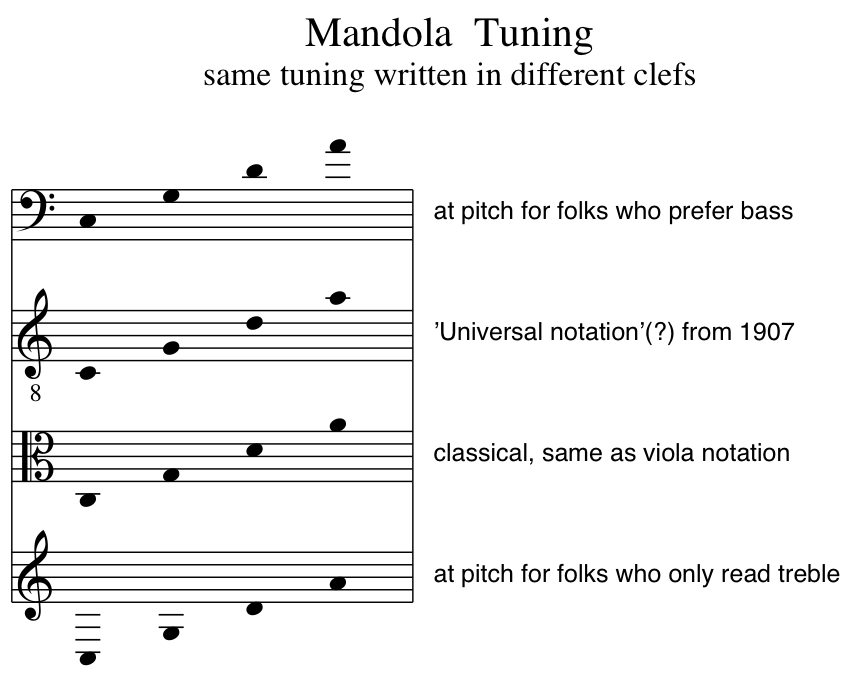05:30 pm - A Question About Mandola Notation
Any mandola players here (especially folk mandolists)?
I've been working on a tune that's intended primarily for guitar but I wanted to make a fiddle version as well, and I realized that it fits more comfortably in the viola range than the violin range (it's supposed to sound low; a viola can play it an octave higher but a violin has to go a full two octaves up from the pitches in my head). And hey, as long as I'm doing a viola version I may as well do it for mandola as well, right?[1] Only problem is, I'm not sure what clef to use for mandola, and a casual search of the web provides conflicting answers -- I can find web sources to support all four of my guesses (with the last two appearing to be enough less common that I might not have to worry about them):

- in treble clef, written an octave higher than it sounds, just like guitar music[2], so the open C string (sounding an octave below middle-C) is written as middle-C
- in alto clef just like a viola (which seems the most sensible but might not be folk-musician friendly?), so the open C string is written below the first ledger line under the staff,
- in treble clef written at pitch (certainly straightforward but requires lots of ledger lines), so the open C string is written below the fourth ledger line under the staff, or
- in bass clef at pitch, so the open C string is written in the second space, and the open A string is written over the third ledger line above the staff.
I already know what to do for viola (I think[3]), but if any mandola players (especially folkies) are reading this, please comment below to let me know what clef(s) you prefer and/or expect to see mandola parts written in. Treble or alto? (Or "don't care as long as there's tab[4] with it?) Thanks.
(I asked this elsewhere recently as well, and had intended to ask here at the same time, but I've had few enough responses that casting the question before a larger audience makes sense. I haven't trued rec.music.makers.* yet -- is there a newsgroup where mandolists would be likely to read, or is r.m.m.guitar about as close a match as I'm likely to find?)
[1] I'm experimenting -- or rather tinkering -- with an unfortunately-large pile of preprocessor directives stuffed into an ABC file so that, without editing the file in between uses, I can generate sheet music in appropriate clefs and suitable octaves, with or without tabulature, for a bunch of different instruments. (So adding correct mandola notation & tab is actually more useful as part of tweaking and testing that, than for handing to a mandolist in person, given how seldom I see mandolas outside of music stores. The system is too complex to be worth the trouble for most tunes, but figuring it out has been an interesting exercise, and it's kind of nifty to be able to get a PDF in the right clef, octave and tabulature for mandolin just by putting "-MANDOLIN" on the command line, then getting the right clef, octave, and tabulature for bass guitar by putting "-BASS" there instead.
[2] But curiously, in all the examples I've seen so far, without the little '8' below the clef which guitar music uses to indicate the same thing -- apparently a convention at one time was to put slashes across the treble clef to indicate the number of octaves lower the music should sound, but I can't recall ever seeing that either.
[3] In the past when I've been asked for viola-friendly versions of music, the request has been for alto clef ... but in my search for answers to the mandola question I learned that there are some players who prefer to read in treble clef, or who prefer to treat the viola as a transposing instrument and read the notes which if played by violin fingerings on a viola would produce the notes of the viola part. Are either of those common enough for me to worry about, or should i be okay with just using alto clef for viola music?
[4] Personally, I'm slower at reading tabulature than reading standard notation, but I'm getting much better at writing tab for folks who require it (or merely prefer it), and my tab-reading skill is gradually improving as a side effect! Funny thing though ... because the program I'm using, abctab2ps, uses a system based on French lute tabulature for its input regardless of which system you're going to ask it to print, I'm currently a little better at that than I am at guitar tab even though I've been seeing guitar tab everywhere for far longer than I've been encountering French lute tab anywhere. (The program will also print out German lute tab, but I don't read that at all.)